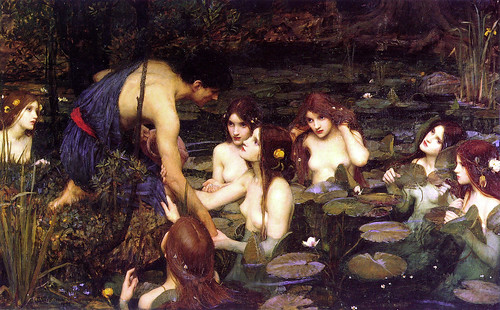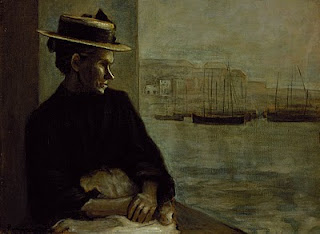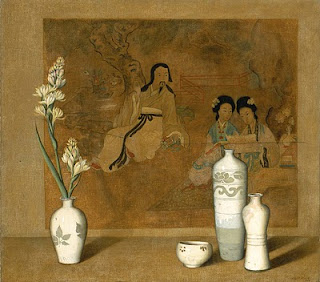
Monday, May 31, 2010
Frank Holl - The Song Of The Shirt [1874]

Tina Tobiassen - Dream

See: http://www.tinatobiassen.com
Sunday, May 30, 2010
John William Waterhouse - Hylas and the Nymphs
Waterhouse, who seems fascinated with the hypnotic power of beauty and youth, utilized the setting of mythology and fiction as an acceptable medium through which he could explore erotic forms. The female nude stands, adored by Waterhouse, as the ultimate expression of the organic and natural aesthetic. Women, capable of possessing power through their sexuality, become free from the domestic interior, embracing nature and themselves.
Saturday, May 29, 2010
John R Grabach - Vanity

[Oil on canvas mounted on wood, 50.7 x 40.6 cm]
Friday, May 28, 2010
Pieter Aertsen - The Egg Dance [1552]
Henry Golden Dearth - The Blue Coat [c.1912]
Thursday, May 27, 2010
Lawrence Alma-Tadema - The Finding of Moses

According to the book of Exodus, Moses was born to a Hebrew mother who hid him when the Pharaoh ordered all newborn Hebrew boys to be killed, and ended up being adopted into the Egyptian royal family. After killing an Egyptian slave master, he fled and became a shepherd, and was later commanded by God to deliver the Hebrews from slavery. After the Ten Plagues were unleashed on Egypt, he led the Hebrew slaves out of Egypt, through the Red Sea, where they wandered in the desert for 40 years. Despite living to 120, he did not enter the Land of Israel, as he disobeyed God when instructed on how to bring forth water from a rock in the desert.
Isaak Levitan - Evening Bells [1892]
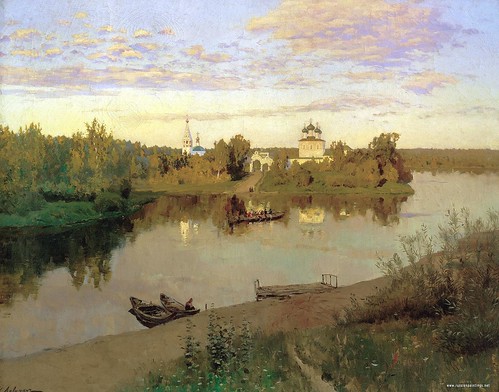
Wednesday, May 26, 2010
John William Waterhouse - A Naiad

Alexandre Cabanel - Albayde

Tuesday, May 25, 2010
Cornelis Springer - Zuiderhavendijk, Enkhuizen [1868]
[Oil on panel, 50 x 65 cm]
Kara Hendershot - Daydreamer 2009
See: www.mnartists.org/Kara_Hendershot
[Acrylic and oil on 5 canvasses, 70 x 60 inches]
Monday, May 24, 2010
Edward John Poynter - The Cave of the Storm Nymphs [1903]

From the turn of the century Poynter's paintings declined both in numbers and quality, his main priority being the running of the Academy. He lived to see the death of classicism, and the total eclipse of his own artistic standards, and those of his contemporaries. He adopted the approach of ignoring new developments of which he did not approve. Unhappily Poynter outstayed his welcome. There was, though, something splendid about the way he remained consistent to the last, resisting what he saw as the corruption, and denigration of all that was beautiful in art. He may even have been right.
Ibram Lassaw - Untitled [1970]

Sunday, May 23, 2010
Rembrandt - The Night Watch [1642]

Hannah Mizen - Laguna Verde [2009]

Saturday, May 22, 2010
Gustav Klimt - The Kiss [1907-08]

Ian Strawn - I'm So Adjective I Verb Nouns [2008]

Friday, May 21, 2010
William Bouguereau - The First Mourning [1888]
Giovanni Segantini - Return of the Wood
Edwin Harris - Arranging The Irises [1897]
Kelly Fitzpatrick - Watermill [1934]
Thursday, May 20, 2010
Isaac Soyer - Art Beauty Shoppe [1934]
[Oil on canvas, 106.7 x 125.7cm]
Paul Cezanne - The Temptation of Saint Anthony [c.1870]

One of the preconditions of Cézanne’s greatness is his constant readiness to change. In this sense The Temptation of St. Anthony, a very strange work in itself, is highly typical of Cézanne. The painter, around thirty years old, fated for a business career by his ambitious father, is still a youthful tyro. Without any real academic training, which he had not obtained in the Académie Suisse in Paris, he relies on finding models among the old masters.
Creative restlessness drives him in this picture to flightiness, his Provençal preference for the Baroque to stilted poses and theatrical gestures. The female nudes with their uncouth limbs appear bloated; drapery frames them like rococo shells. In front of this turbulent appearance of the four temptresses is St. Anthony, bearing the features of the young Cézanne, retreated into the left background, without the artist’s having succeeded in making it clear in terms of perspective. Cézanne’s rough brushwork, called by the artist himself his "manière couillarde", "slinging style", renounces all differentiation and slaps down the chalky white figures directly on to the dark background.
Cézanne was occupied with the theme of the temptation of St. Anthony several times in the 1870s. The crouching nude in the foreground with her hair falling behind becomes a richly varied component of his "Bathers" down to the great compositions done at the end of his life.
Wednesday, May 19, 2010
Deletion of Posts
Arthur Hacker - The Temptation of Sir Percival [c.1894]
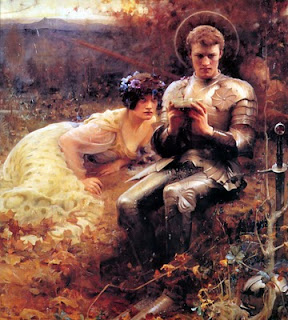
Arthur Hacker (September 25, 1858 – November 12, 1919) was an English classicist painter. Born in London in 1858, Hacker was the son of Edward Hacker, a line engraver specialising in animal and sporting prints (who was also for many years the official Registrar of Births, Marriages and Deaths for Kentish Town in the St Pancras registration district, north London). In his art he was most known for painting religious scenes and portraits, and his art was also influenced by his extensive travels in Spain and North Africa. He studied at the Royal Academy between 1867 and 1880, and at the Atelier Bonnat in Paris. He was twice exhibited at the Royal Academy, in 1878 and 1910. He died in London on November 12, 1919.
Tuesday, May 18, 2010
Uab Sanasen - Silent
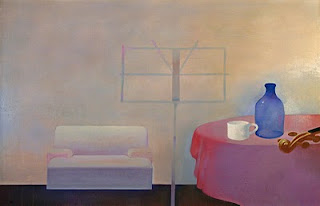
“A retrospective art exhibition by Uab Sanasen, a nationally recognized painter and a respected art teacher, will be held at The Queen’s Gallery on Ratchadamnoen Klang Road, Pan Fah Bridge, Bangkok, from November 26, 2007 through to January 31, 2008. Uab Sanasen, who is well known among art connoisseurs, turns 72 this year. The exhibition is meant to celebrate this occasion and for the general public, students, and art lovers to have a chance to view this master’s life-time works through his paintings and photographs. This will be Arjarn Uab’s first solo exhibition in almost 20 years. It is a rare opportunity for the general public to be able to view his masterpieces from various private and institutional collections, as well as from the artist and his family’s own intimate and beloved paintings.”
[Oil on canvas, 75 x 90 cm]
Monday, May 17, 2010
Red Grooms - Mimi In Green [1962]
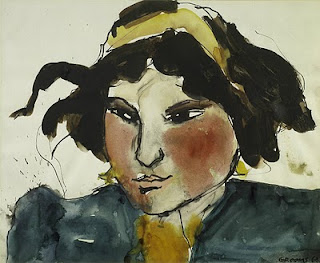
Red Grooms, born Charles Rogers Grooms (June 7, 1937), is an American multimedia artist best known for his colourful pop-art constructions depicting frenetic scenes of modern urban life. Groom was given the nickname "Red" by Dominic Falcone (of Provincetown’s Sun Gallery) when he was starting out as a dishwasher at a restaurant in Provincetown and was studying with Hans Hofmann. He was born in Nashville, Tennessee during the middle of the Great Depression. He studied at the Art Institute of Chicago, then at Nashville's Peabody College. In 1956, Grooms moved to New York City, to enrol at the New School for Social Research. A year later, Grooms attended a summer session at the Hans Hofmann School of Fine Arts in Provincetown, Massachusetts. There he met experimental animation pioneer Yvonne Andersen, with whom he collaborated on several short films.
[Watercolour on paper, 38.1 x 43.18 cm]
Sunday, May 16, 2010
Henri Lebasque - Bather [1920]

Henri Lebasque (1865 - 1937) was born at Champigné (Maine-et-Loire). He started his education at the Ecole des Beaux-Arts d’Angers, and moved to Paris in 1886. Here, Lebasque started studying under Léon Bonnat, and assisted Humbert with the decorative murals at the Panthéon. Around this time, Lebasque met Camille Pissarro and Auguste Renoir, who later would have a large impact on his work.
Lebasque's vision was coloured by his contact with younger painters, especially Edouard Vuillard and Pierre Bonnard, founders of the The Nabis' Group and the Intimists who first favoured the calm and quietude of domestic subject matter. From his first acquaintance with Georges Seurat and Paul Signac, Lebasque learnt the significance of a colour theory which stressed the use of complementary colours in shading. Lebasque had some commercial success during his lifetime. He worked on the decorations at the theatre of the Champs-Elysées and of the Transatlantique sealiner. Lebasque died at Cannet, Alpes Maritimes in 1937.
Saturday, May 15, 2010
Mervin Jules - The Bar At Rosy's [1977]

Born in Baltimore, Mervin Jules received artistic training at Baltimore City College and the Maryland Institute College of Art, graduating in 1934. Prior to his study, in Baltimore Jules designed silk prints, painted china, cared for children and helped in his father's clothing shop in order to make ends meet; he received a scholarship to attend MICA in 1932 at the age of 18. Jules typically used dramatic and evocative lighting where sinewy figures emerge from darkened backgrounds, much like the paintings of Daumier. Like other social realist artists, his subjects are most often depictions of the plight of the poor and disadvantaged. Jules' works also encompassed satires against fascism and social ills. He died in Provincetown, Massachusetts in 1994.
[Oil on canvas, 101.0 x 151.7 cm]
Friday, May 14, 2010
Michael Flohr - Night Life

Michael Flohr is a young California artist, currently living and working in San Diego where he was born and raised. With his parents’ encouragement, he began painting at the young age of five and later on pursued a degree at the San Francisco Academy of Art College, graduating in 1999. He has also been recognized into New York’s Society of Illustrators, joining the ranks of legendary predecessors such as Norman Rockwell, Maxfield Parrish and N.C. Wyeth.
Depicting ordinary moments in extraordinary ways, Michael Flohr’s work displays an artistic mastery of colour, perspective, technique and vision. Largely urban in content with a European flair, his paintings cover subject matter ranging from nightlife scenes, cityscapes, still lifes and figurative portraiture.
Inspired by the works of master impressionists, Flohr prefers to paint in oils and comments, “I love oil paint because of its durability and the richness it brings to the canvas. I also believe that most people with an appreciation for art respect an artist’s use of this classic medium.”
Thursday, May 13, 2010
Vasily Krillovich Nechitailo - Brigadier Of Communist Workers [1964]
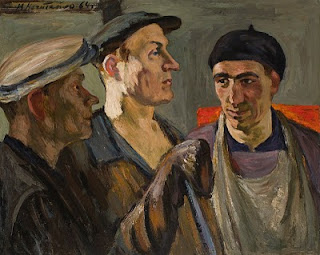
Vasili Kirillovich Nechitailo was born in Nikolaevskoe, the province of Rostov-on-Don, in 1915. In 1931 he began his study of art at the Krasnodar Art Tekhnikum where he remained until 1935. In 1935 the artist entered into preparatory art courses at the Surikov Institute. After approximately two years of preperation, Nechitailo enrolled in the Moscow Art Institute as a full time student under the tutelage of the revered professor Gerasimov. He attended the Institute from 1937 to 1942. The artist then enrolled in their graduate program in 1942. In 1943, while still attending the Surikov, Nechitailo and 11 other academically accomplished artists were evacuated to Samarkand, Uzbekistan for the duration of the war. It looked like Moscow might fall to the Germans so the Soviet government decided to evacuate their most promising artists who they saw as cultural assets. He returned and completed his graduate degree in 1944. He was honoured with the opportunity to teach at the Surikov Institute from 1948 until 1956. Vasili Nechitailo began to actively exhibit in 1945. Nechitailo died in Moscow in 1980.
[Oil on canvas, 80.50 x 100.50 cm]
Wednesday, May 12, 2010
Tuesday, May 11, 2010
Charles Demuth - The Figure 5 in Gold [1928]

Charles Demuth (November 8, 1883 - October 23, 1935) was an American water-colourist who turned to oils late in his career, developing a style of painting known as Precisionism. Demuth suffered either an injury when he was four years old or may have had polio or tuberculosis of the hip that left him with a marked limp and required him to use a cane. He later developed diabetes and was one of the first people in the United States to receive insulin. He spent most of his life in frail health, and he died in Lancaster at the age 51 of complications from diabetes.
This painting pays homage to a poem by William Carlos Williams. Williams' poem The Great Figure describes the experience of seeing a red fire engine with the number five painted on it racing through the city streets. While Demuth’s painting is not an illustration of Williams’ poem, we can certainly sense its "rain and lights" and the "gong clangs, siren howls, and wheels rumbling." The bold 5 both rapidly recedes and races forward in space, and the round forms of the number, the lights, the street lamp, and the arcs at the lower left and upper right are played against the straight lines of the fire engine, the buildings, and the rays of light, infusing the picture with a rushing energy that perfectly expresses the spirit of the poem.
Monday, May 10, 2010
Tom Wesselmann - Bedroom Face
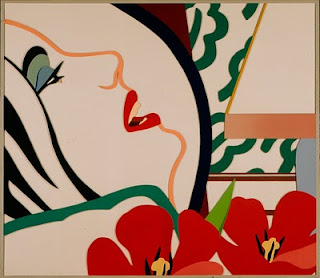
Tom Wesselmann (February 23, 1931, Cincinnati - December 17, 2004) was an American pop artist who specialized in found art collages. Wesselmann's series Great American Nude (begun 1961) first brought him to the attention of the art world. The series incorporated representational images with an accordingly patriotic theme, such as American landscape photos and portraits of founding fathers.
He worked constantly on the Bedroom Painting series, in which elements of the Great American Nude, Still Lifes and Seascapes were juxtaposed. With these works Wesselmann began to concentrate on a few details of the figure such as hands, feet, and breasts, surrounded by flowers and objects. The Bedroom Paintings shifted the focus and scale of the attendant objects around a nude; these objects are small in relation to the nude, but become major, even dominant elements when the central element is a body part.
Sunday, May 9, 2010
Bryan Larsen - Deliberation
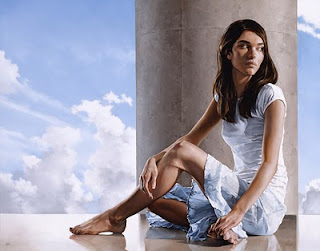
"I have been drawing as long as I can remember. By the time I was in high school, I knew I wanted to be an artist, although at the time I didn't have a clear idea of how exactly I would use my talents to make a living. As I continued studying art, I began to suspect that fine visual art was dead. No one seemed interested in teaching students how to draw well, or paint well. More often than not, my own skills exceeded those of my instructors. The only field left that seemed to require good drawing, painting, and compositional skills was illustration, and therefore I began studying illustration at Utah State University in Logan, Utah. In my second year at Utah State, I met Damon Denys. In discussing Art with him I realized that there were other people who believed that technique and subject matter were indispensable components of any work of art. I then decided that I would work to develop my own painting skills with the purpose of creating artwork that I considered worthy of being called Fine Art.”
[Oil on linen, 38 x 30 inches]
Saturday, May 8, 2010
Paul Gauguin - The Milkmaid [1889]
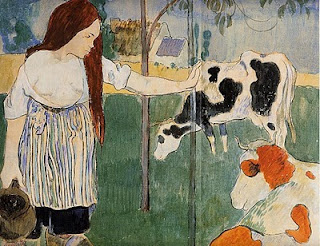
Gauguin produced this painting by applying egg tempera onto canvas. Egg tempera is a painting process that uses egg yolk to bind pigments. The artist must manufacture the paints him or herself by the simple process of mixing finely ground pigment, water and dilute egg yolk. Tempera is normally applied in thin, semi-opaque or transparent layers. When dry, it produces a smooth matte finish. Because it cannot be applied in thick layers as oil paints can, tempera paintings rarely have the deep colour saturation that oil paintings can achieve. On the other hand, tempera colours do not change over time, whereas oil paints darken, yellow, and become transparent with age.
Friday, May 7, 2010
Sergio Rangel - Beautiful Deterioration
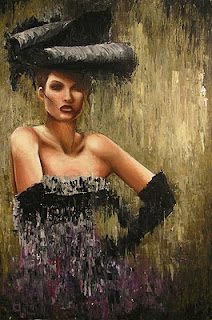
Sergio Rangel was a student at Pasadena Memorial High School, when he won ninth place for this painting in the 2008 Culture Shapers Visual Arts Contest.
The annual Culture Shapers Visual Arts Contest enables student artists to compete for nearly $70,000 in cash prizes in six categories... drawing, painting, electronic media, mixed media, photography and sculpture. The contest takes place in the autumn, and is open to all High School Students in Harris, Waller, Liberty, Chambers, Galveston, Brazoria, Fort Bend, and Montgomery counties.
Culture Shapers jurors are a combination of educators and professionals, who come highly recommended to us by other notable organizations, such as the Visual Arts Scholastic Event (VASE), as well as others. Many of our jurors have experience both in and out of the classroom, which gives them a unique and valuable perspective on evaluating student artwork.
Thursday, May 6, 2010
Ethelyn Cosby Stewart - Sung Tranquillity [1936]
Wednesday, May 5, 2010
Roselina Hung - The Return Home
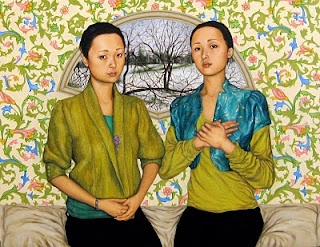
Roselina Hung received an MA Fine Art in Painting from Central Saint Martins College of Art & Design, and a BFA from the University of British Columbia. She also spent a year at L’Ecole National Superieure des Beaux-Arts, in Paris. Her work has exhibited internationally and can be found in private collections around the world. Born in 1980, Vancouver, Canada; she currently lives and works in Vancouver.
[Oil on oak, 31.7 X 38.7 cm]
See: http://www.roselinahung.com
Tuesday, May 4, 2010
Donald M Mattison - Portrait of the Davico Sisters [before 1934]
Monday, May 3, 2010
Gladys Nilsson - Arytystic Pairanoiya [1978]
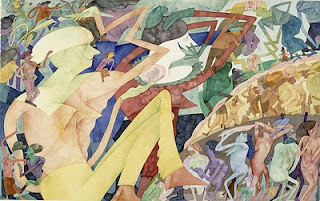
Gladys Nilsson (born 1940) is a Chicago artist, one of the original Chicago Imagists, a group in the 1960s and 1970s who turned to representational art. Her paintings "set forth a surreal mixture of fantasy and domesticity in a continuous parade of chaotic images." She is married to fellow-artist and Hairy Who member Jim Nutt.
[Watercolour and pencil on paper sheet, 63.9 x 102.4 cm]
Sunday, May 2, 2010
John Lewis Krimmel - The Quilting Frolic [1813]
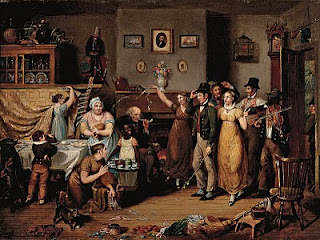
Krimmel (American, born Germany, 1786–1821) gathered information for his paintings in the field, observing local habits, rituals, and ceremonies in Philadelphia, so even though he took his compositional formats from British models, popular prints made after paintings by the satirical artists William Hogarth and David Wilkie, he keyed his subject matter to his potential audience at the Pennsylvania Academy. In this canvas, a richly detailed parlour, which evokes the burgeoning middle-class consumer culture, provides the setting for the narrative: a group of smartly dressed folks, accompanied by a minstrel, have burst in to celebrate the completion of a quilt before the seamstresses have cleaned up their scraps of fabric and sewing implements or changed into party attire. A critic applauded in 1813: "The subject is good and executed with great judgment, and if Mr. Krimmel only perseveres in the path he has chosen, we are decidedly of opinion that his labours will contribute largely towards giving character to the arts in our country."
Saturday, May 1, 2010
František Kupka - Vertical Plains Blue and Red [1913]

František Kupka (September 23, 1871 - June 24, 1957) was a Czech painter and graphic artist. He was a pioneer and co-founder of the early phases of the abstract art movement and orphic cubism (Orphism). Kupka's abstract works arose from a base of realism, but later evolved into pure abstract art. František Kupka was born in Opočno, eastern Bohemia (now Czech Republic). Kupka had a strong interest in colour theory; around 1910 he began developing his own colour wheels, adapting a format previously explored by Sir Isaac Newton and Hermann von Helmholtz. This work in turn led Kupka to execute a series of paintings he called "Discs of Newton" (1911-12). Kupka was interested in freeing colours from descriptive associations. His work in this area is thought to have influenced other artists like Robert Delaunay.
